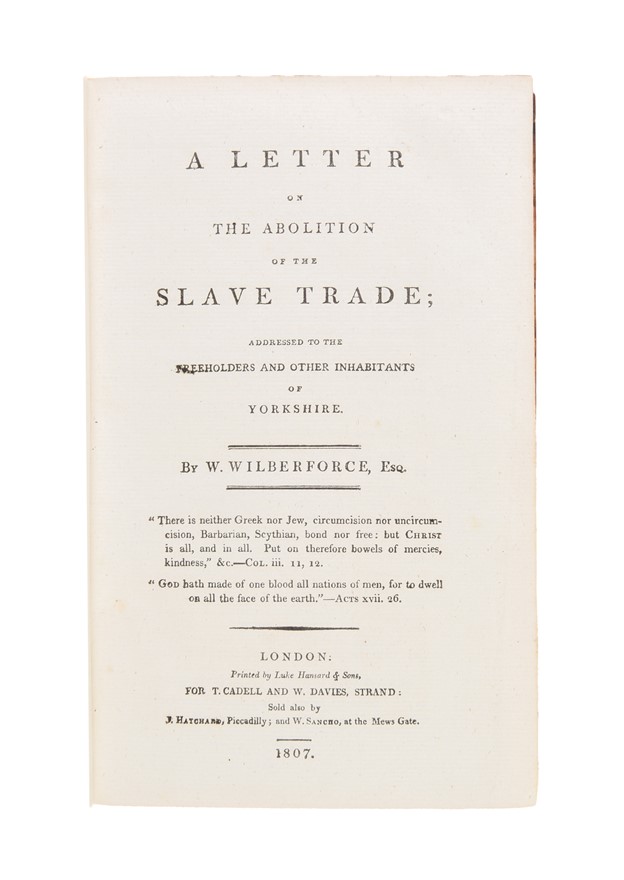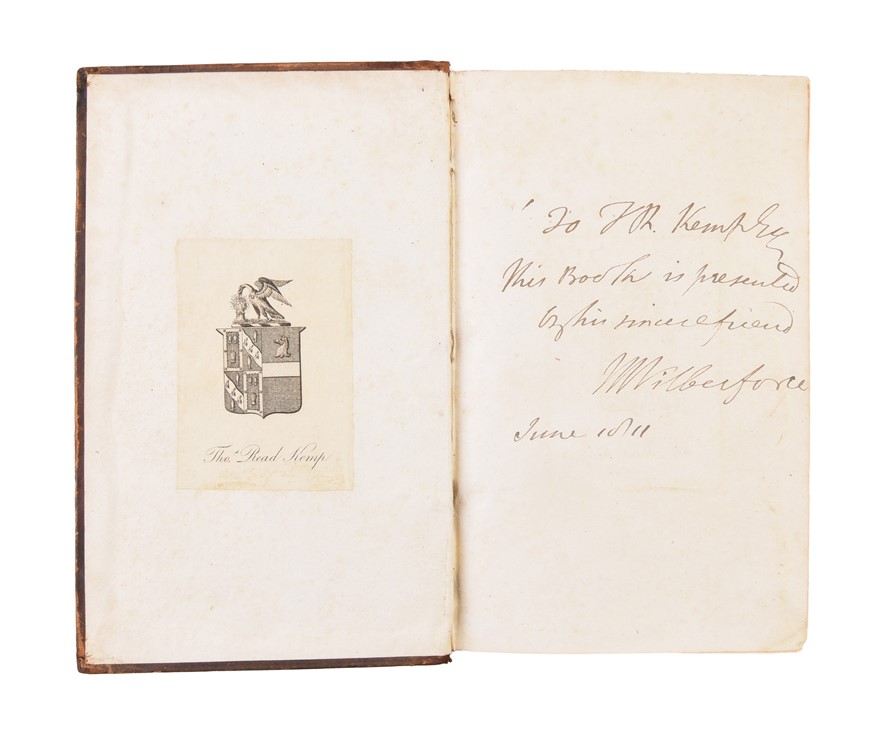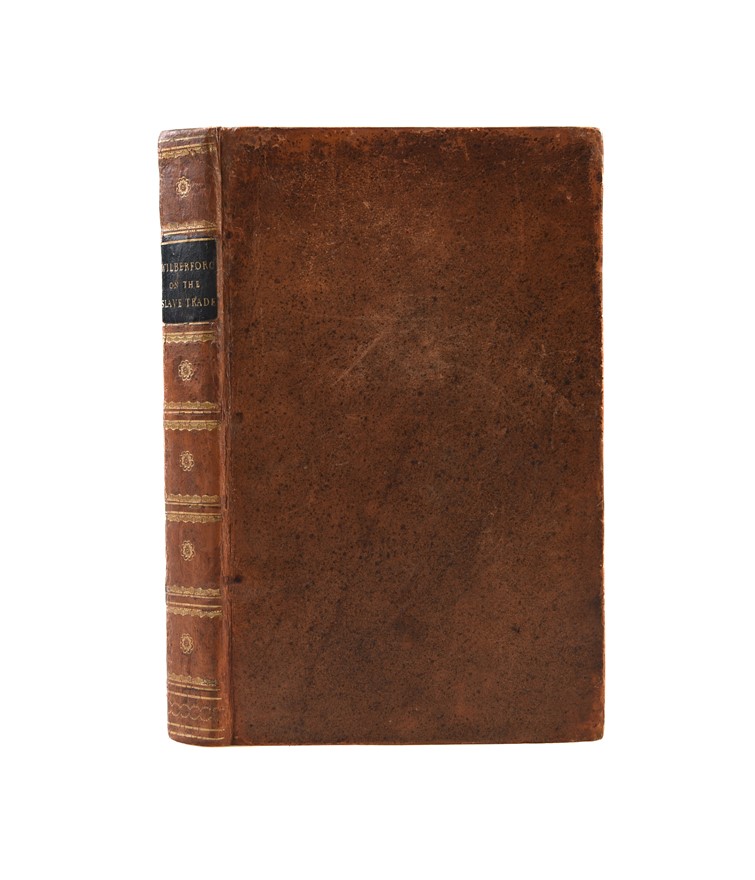A Letter on the abolition of the slave trade; addressed to the freeholders and other inhabitants of Yorkshire.
WILBERFORCE William.; SANCHO William publisher (1807.)
£25000.00 [First Edition]
Please contact us in advance if you would like to view this book at our Curzon Street shop.
AUTHOR'S PRESENTATION COPY OF THE SANCHO ISSUE
First edition, presumed second issue. 8vo. Full contemporary speckled calf, label gilt tooling and titles to spine, joints sensitively restored. Armorial bookplate to front pastedown of Tho's. Read Kemp. Inscribed by the author in ink on ffep. With the half-title. A near fine copy. iv, 396pp. London, Luke Hansard & Sons, for T. Cadell and W. Davies ... J. Hatchard; and W. Sancho, at the Mews Gate,
An especially desirable copy of Wilberforce's great statement of the abolitionist position. Not only is it a presentation copy, it was published by William Leach Osborne Sancho (1775-1810) - son of the famous Ignatius Sancho - and the founder of the first Black-owned publishing house in the English-speaking world.
Published while Wilberforce's soon-to-be triumphant bill to abolish the slave trade was in the Lords, the work "consolidated and restated the formidable array of evidence and argumentation against the trade that Wilberforce has developed over the previous two decades" and "served to inform the final phase of the struggle" (ODNB). Wilberforce begins by noting that 14 years have passed since the issue of the slave trade was argued fully in parliament and that "during the intervening period, also, such strange and interesting spectacles have been exhibited at our very doors, as to banish from the minds of most men all recollection of distant wrongs and sufferings". As a consequence, Wilberforce writes that "it may not be useless thus publicly to record the facts and principles on which the Abolitionists rest their cause, and for which, in the face of my country, I am willing to stand responsible."
Wilberforce then illustrates his arguments with examples from works as diverse as Hume's Essays and Edward's History of the West Indies among others. Pages 353 to 396 contain an appendix of "extracts from the older authors" which mainly describes "depredatory acts occasioned by the slave trade".
William Sancho had only been in business for four years when he published this work. After his father's death in 1780, the family continued to live at 19/20 Charles Street, where Ignatius ran his grocery shop. With some income generated from sales of the first four editions of Letters of the late Ignatius Sancho, an African (London, 1782), Sancho's son and heir William, established himself as a publisher and bookseller in association with his mother Anne. Letters held in the British Library suggest that he was supported and encouraged in this pursuit by long term friend and correspondent of his father's, Norwich based bookseller and painter William Stevenson.
Sancho published an eclectic mix of works ranging from a translation of Voltaire and a treatise on cow-pox, to a few choice abolitionist titles such as this one. He also saw into print the 1803 fifth edition of his father's letters.
A sketch of him provided in the 1807 fifth volume of the Wonderful Museum and Magazine suggests that he was "brought up to the profession of bookseller by Mr. Edward Jeffrey, of Pall-Mall, and at present is the worthy successor of Mr. Henry Paine at the Mews Gate in Castle Street." The same sketch goes on to erroneously attribute him to the position of librarian to Sir Joseph Banks - with whom he may well have had business dealings however. Thomas Frognall Dibdin in the 1817 third volume of his Bibliographical Decameron further supports the fact that William Sancho did indeed at some point after 1804 take over the shop in Mews Gate, Castle Street, previously run by Thomas Payne (misnamed 'Henry Paine' in the Wonderful Museum). That address appears on the title-page here. Dibdin further described Sancho: "our sooty bibliopolist, had the most ardent passion for books: and especially for English topography and black letter ..." (Dibdin, 438).
His father’s fame ensured his own name was known in abolitionist circles and as described in the abstract of unpublished letters in Besterman's book on the Cadell and Davies archive, Wilberforce personally requested that "Mr. William Sancho, a man of colour, to be added to the list of publishers" for the present work (172). In another document described in the Cadell and Davies papers, we see that in the month of February Sancho had sold 12 copies compared to Hatchard’s 75. This may speak to the number of copies allocated to him, or indeed just the relatively small size of his business. It also gives the total size of the edition as 1493 copies.
The presentation inscription reads: "To Th Kemp Esq, This book is presented by his sincere friend Wilberforce June 1811". The copy also bears Kemp's bookplate to the front pastedown. Thomas Read Kemp (1782-1844) was a property speculator and Whig politician, who in 1811 (the year this copy was inscribed to him) inherited his father's estate and became MP for Lewes making him an important and influential potential supporter of the abolition movement. In the same year Kemp (and Wilberforce) are listed as Vice Presidents of the African and Asiatic Society. At the Society's dinner on 19th July that year the committee reported that "nearly 240 cases of deep affliction have been relieved [by the Society] during the past year. Upwards of 50 persons of colour have in the same time joined the Benefit Society, established by the Africans themselves...it appeared also to be the wish of the Society, to enlarge the sphere of benevolence by the adoption of such plans as may be commensurate with the wants and miseries of the natives of Africa and Asia in this metropolis." (The Evangelical Magazine, Volume 19, 1811) Kemp was also actively involved in the evangelical church, and stood between 1812-1816 as the vice-president of the Church Missionary Society. He was an advocate of free trade. Wilberforce's presentation of this book to Kemp constitutes a primer or guide book and useful history of the movement for the future generation of English abolitionists.
Substantially rarer than the first issue, aside from the title-page, it differs only in the correcting of a misprint of an early signature mark. Indeed, OCLC records copies being held at Indiana, Aberdeen, and York only.
Besterman, T., ed The publishing firm of Cadell and Davies : Select correspondence and accounts, 1793-1836 (London, 1938), p.172; Carey, Brycchan, British Abolitionism and the Rhetoric of Sensibility, (New York, 2005); Dibdin, T.F., Bibliographical Decameron, (London, 1817), p.438; Ellis, Markham, The Politics of Sensibility: Race, Gender, and Commerce in the Sentimental Novel, (Cambridge, 1996); King, Reyahn, Ingatius Sancho: An African Man of Letters, (London, 1997);PMM, 232b; Sabin, 103953.
Stock Code: 247355






